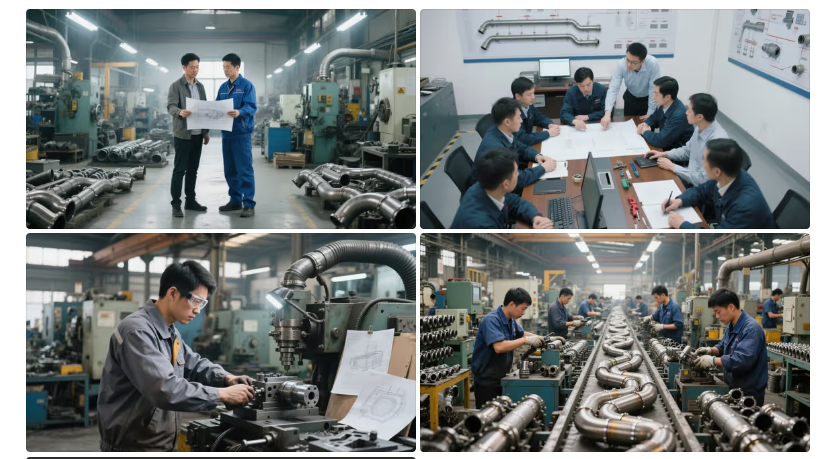How to OEM?

1. Demand Analysis and Technical Alignment
Customer Input:
1.Provide product design drawings (2D/3D), technical standards (e.g., ISO, SAE), and material requirements (e.g., high-temperature-resistant steel).
2.Define performance metrics (e.g., sealing, vibration resistance), production volume, and delivery timeline.
Manufacturer Assessment:
Review design feasibility (DFM analysis), cost estimation, and production capacity alignment, providing optimization suggestions (e.g., structural modifications to reduce machining difficulty).
- Process Design and Development
Process Planning:
1.Determine the manufacturing route (e.g., stamping + welding + electroplating) and select equipment (e.g., 5-axis CNC for complex flanges).
2.Design molds/fixtures (e.g., clamp crimping dies, flange punching dies).
Prototyping:
1.Rapid prototyping (3D printing/small-batch trial production) to validate dimensions, assemblability, and functionality.
2.Iterate based on customer testing feedback (e.g., adjusting bolt hole spacing on clamp flanges)
3. Production Preparation and Validation
Supply Chain Coordination:
Procure compliant raw materials (e.g., 304 stainless steel strips) and outsourced components (e.g., rubber sealing rings).
Trial Production (PPAP Process):
1.Small-batch pilot production, submitting Production Part Approval Process (PPAP) documents (including material reports, process flowcharts, full-dimension inspection reports).
2.Critical tests: Salt spray test (anti-corrosion), dynamic fatigue testing (e.g., vibration endurance of exhaust pipe clamps).
4. Mass Production and Quality Control
Large-Scale Production:
1.Automated production lines (e.g., robotic welding) ensure consistency in batch processing of flange clamps.
2.Process control: SPC (Statistical Process Control) monitors key parameters (e.g., flange thickness ±0.1mm).
Quality Inspection:
1.100% inspection: Clamp inner diameter, flange flatness.
2.Sampling inspection: Tensile test (ensuring fastening force), leak test (e.g., for turbocharger piping connectors).
5. Delivery and After-Sales Support
Logistics and Packaging:
Custom packaging (scratch-resistant blister trays), Just-in-Time (JIT) delivery to customer assembly lines.
Continuous Support:
Provide batch traceability documentation and rapid response to design changes (e.g., material updates due to emission standard upgrades).
Why Choose us?
1.Precision Design Execution: High-accuracy machining (e.g., laser cutting ±0.05mm) ensures compliance with OEM standards.
2.Cost Optimization: Economies of scale and process improvements (e.g., progressive die stamping) reduce unit costs.
3.Rapid Response: Flexible production lines adapt to low-volume, high-mix demands (e.g., special flanges for NEV models).






